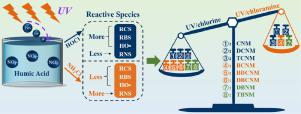Water Research ( IF 12.8 ) Pub Date : 2022-09-27 , DOI: 10.1016/j.watres.2022.119175 Tingting Huang 1 , Lin Deng 1 , Tao Wang 1 , Xueying Liao 1 , Jun Hu 1 , Chaoqun Tan 1 , Rajendra Prasad Singh 1

|
UV/chlor(am)ine are efficient for achieving multiple-barrier disinfection and maintaining residuals, while bromide (Br−) has notable impacts on the formation and toxicity of halonitromethanes (HNMs) during UV/chlor(am)ine disinfection. This study investigated the effects of Br− on HNMs formation and toxicity alteration during UV/chlor(am)ine disinfection of nitrate containing humic acid (HA) water. Results reveal that the maximum concentration of HNMs during UV/chlorine disinfection was 12.03 μg L−1 with 0.2 mg L−1 Br−, which was 22.5% higher than that without Br−, and the predominant species of HNMs were converted from trichloronitromethane (TCNM) to dibromonitromethane (DBNM) and tribromonitromethane (TBNM). However, the maximum concentration of HNMs during UV/chloramine disinfection was 3.69 μg L−1 with 0.2 mg L−1 Br−, which was increased by 26.0% than that without Br−, and the predominant species of HNMs were converted from dichloronitromethane (DCNM) to bromochloronitromethane (BCNM) and DBNM. Notably, the HNMs species and yields during UV/chloramine disinfection were less than those during UV/chlorine disinfection, primarily due to the higher concentrations of HO· and reactive chlorine/bromine species in UV/chlorine. Also, in the ranges of the Br−:Cl2 molar ratio from 0 to 0.32 and pH from 6.0 to 8.0, the Br−:Cl2 molar ratio of 0.16 and acidic pH contributed to the HNMs formation during UV/chlorine disinfection, and a high Br−:Cl2 molar ratio and neutral pH contributed to the HNMs formation during UV/chloramine disinfection. Note that the incorporation of Br− significantly improved the calculated cytotoxicity (CTI) and genotoxicity (GTI) of HNMs formed, and the calculated CTI and GTI of HNMs formed during UV/chloramine disinfection were 28.19 and 48.90% of those during UV/chlorine disinfection. Based on the diversity of nitrogen sources, the possible formation pathways of HNMs from nitrate containing HA water were proposed during UV/chlor(am)ine disinfection in the presence of Br−. Results of this study indicated that UV/chloramine can reduce the formation and toxicity of HNMs efficiently.
中文翻译:

溴离子对含硝酸盐腐植酸水紫外/氯胺消毒过程中卤代硝基甲烷生成及毒性变化的影响
UV/chlor(am)ine 可有效实现多重屏障消毒和保持残留物,而溴化物 (Br - ) 在 UV/chlor(am)ine 消毒过程中对卤代硝基甲烷 (HNMs) 的形成和毒性具有显着影响。本研究调查了在对含有腐植酸 (HA) 的硝酸盐进行紫外线/氯胺消毒期间Br -对 HNM 形成和毒性变化的影响。结果表明,在紫外线/氯消毒过程中,HNMs 的最大浓度为 12.03 μg L -1和 0.2 mg L -1 Br -,比没有 Br -时高 22.5%, HNMs 的主要种类从三氯硝基甲烷 (TCNM) 转变为二溴硝基甲烷 (DBNM) 和三溴硝基甲烷 (TBNM)。然而,在紫外线/氯胺消毒过程中,HNMs 的最大浓度为 3.69 μg L -1和 0.2 mg L -1 Br -,比没有 Br -时增加了 26.0% ,并且 HNMs 的主要种类由二氯硝基甲烷转化而来( DCNM) 为溴氯硝基甲烷 (BCNM) 和 DBNM。值得注意的是,紫外线/氯胺消毒期间的 HNMs 种类和产量低于紫外线/氯消毒期间的那些,这主要是由于紫外线/氯中 H2O·和活性氯/溴种类的浓度较高。此外,在 Br - :Cl的范围内2摩尔比从 0 到 0.32,pH 从 6.0 到 8.0,0.16 的 Br - :Cl 2摩尔比和酸性 pH 有助于紫外线/氯消毒过程中 HNMs 的形成,高 Br - :Cl 2摩尔比和中性在紫外线/氯胺消毒过程中,pH 有助于 HNMs 的形成。请注意,Br 的加入-显着提高了形成的HNMs的计算细胞毒性(CTI)和遗传毒性(GTI),UV/氯胺消毒过程中形成的HNMs的计算CTI和GTI分别是UV/氯消毒过程中的28.19%和48.90%。基于氮源的多样性,提出了在 Br -存在下 UV/氯胺消毒过程中含硝酸盐的 HA 水中 HNMs 的可能形成途径。这项研究的结果表明,UV/氯胺可以有效地减少 HNMs 的形成和毒性。



























 京公网安备 11010802027423号
京公网安备 11010802027423号